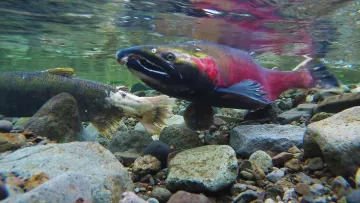By Scott Webb

For the last 15 years, the Salmon Protection and Watershed Network has been fighting in the courts to adopt a science-based Stream Conservation Area Ordinance in the San Geronimo Valley that would protect some of the most vulnerable salmon habitats left in California from development. Litigation has its time and place, but so does compromise. Thanks to the advocacy of community leaders and local environmental organizations such as the Marin Group of the Sierra Club, last month the Marin County Board of Supervisors unanimously passed the Stream Conservation Area Ordinance, expanding protections to some of the most critical coho salmon habitat left in California. While this ordinance may not be perfect, it is a science-based solution that adequately addresses the environmental obstacles.
The Convention on Biological Diversity found that nature is being destroyed at a rate up to hundreds of times higher than the average for the previous 10 million years. Marin County is on the front lines of this crisis, as the loss of streamside habitat has contributed to a 95 percent reduction of coho salmon. The County identified the Lagunitas Creek Watershed as the “most important” coho salmon run in all of California, and the San Geronimo Valley sustain can sustain up to half of the salmonid spawning activity in the watershed.
Adopting this Ordinance was the County’s idea. The 1994 County Wide Plan identified streamside habitat as “irreplaceable and should be officially recognized as essential environmental resources.” This sentiment carried into the 2007 County Wide Plan, which called for “no net loss of sensitive habitat acreage, value, and function.” This initiative became the guiding principle of the final Stream Conservation Area Ordinance.
Policies to achieve this “no net loss of habitat” target include a reduced development allowance within 100 feet of salmon habitat and a 2:1 habitat replacement ratio when development occurs within that 100-foot zone.
The newly adopted Stream Conservation Area Ordinance expands these protections to ephemeral (seasonal) streams, which have significant ecological importance and serve as a transfer system for required nutrients to perennial (year-round) streams supporting salmon. As we saw in October, flooding is already a significant concern in the valley. The health of ephemeral streams will become more imperative in the era of climate change to absorb floodwaters, slowing the pace of water downstream while entraining sediments along the banks.
The Ordinance also lays a pathway for the county to establish a habitat restoration program to restore previously degraded riparian habitat in the San Geronimo Valley.
The best available science will continue to guide the Stream Conservation Area Ordinance. The Board of Supervisors will receive bi-annual reports that quantitatively measure the Ordinance’s efficacy through eight performance indicators, creating a science-driven dialogue on how to best protect the streams.
Marin’s streams are in greater peril now than when the Ordinance was first proposed decades ago. As the valley goes, so do the salmon, making it paramount to protect the riparian habitat we have left while we continue to work hard to restore the habitats that we’ve lost. While the Ordinance may be small in scale, it is an excellent example of how streamside communities can do their part by integrating science-based protections to vulnerable habitats.
We still have a lot of work to do, but days like this remind me of what a small group of motivated folks can achieve when they think globally and act locally. The collaboration of Marin’s environmental communities, including the Sierra Club, was essential in getting this important ordinance over the finish line.
Scott Webb is Advocacy and Policy Manager for Salmon Protection and Watershed Network.
Photo: Salmon courtesy Bureau of Land Management